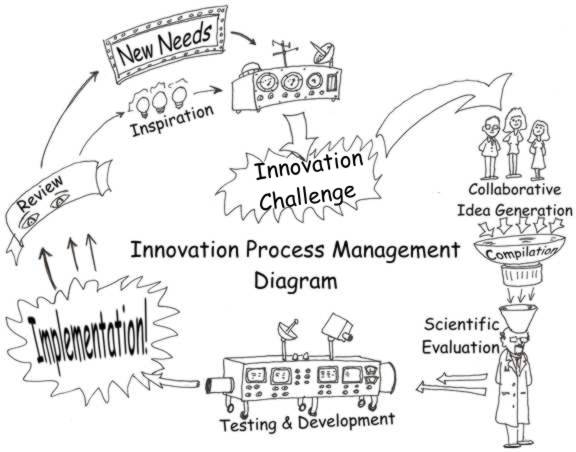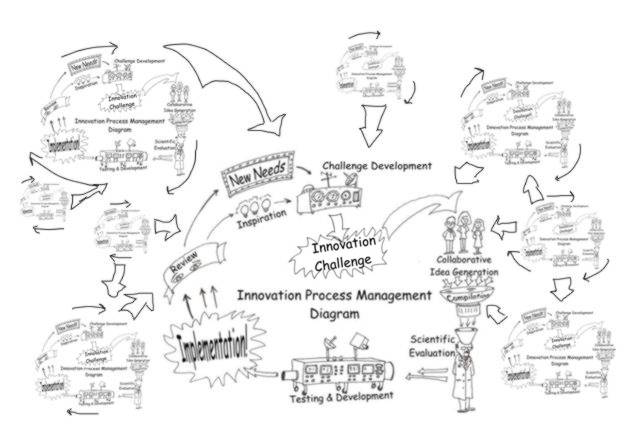Innovation Process Management (IPM)
Jeffrey Baumgartner
With the growing popularity of innovation initiatives, ever more companies are launching their own actions. However, many are going forward in a piecemeal fashion, running a brainstorming event here, trying out an ideas campaign there and promoting innovation in vague ways in marketing communications. Such an approach works, somewhat, but it is not ideal.
The best approach is to have a comprehensive innovation process management (IPM) structure that treats innovation as a series of cycles that run within a grand, enterprise innovation process cycle.
The Innovation Process Cycle

An innovation process cycle combines creative problem solving (CPS) with
scientific peer review evaluation and some typical business tools.
The Challenge
The cycle starts with a problem or goal which needs to be formulated into an
innovation challenge. Once this is done, the challenge is presented to the problem
solving group. This may be done in the form of a brainstorming event, ideas
campaign or other activity. The group problem solving group may be a team, all
employees in the firm, the public or any other group of people.
Collaboration
In order to maximise the creative potential of the problem solving group, the
idea generation activity should be collaborative in nature. This can be accomplished
in many ways. Idea management and innovation process management software often
provides on-line collaboration tools, while facilitators of brainstorming and
other ideation events should promote collaborative idea development.
Combination
Because an innovation process cycle starts with a challenge, ideas tend to be
interrelated and many are complementary. Hence, before going further, it is
best to combine such complementary ideas into larger, more sophisticated ideas
so that they can be handled as a single package. This makes the next steps in
the cycle more efficient.
Scientific Peer Review Evaluation
Here is where a lot of innovation initiatives break down: choosing the best
ideas. Many poorly thought out approaches use voting, which is a good way to
identify the most popular idea, but an appallingly ineffective method for identifying
the most potentially innovative idea. I have also seen organisations put a great
deal of effort into idea generation, leaving the final decision to a manager
who basically picks out her favourite idea. Assuming the manager has suitable
business expertise, such an approach is better than voting – as it is
based on expertise rather than popularity – but it is typically far from
perfect.
The scientific approach of peer review by expert, on the other hand, is ideally suited for identifying the most promising ideas in a cycle. Instead of basing selection on popularity (can you imagine Einstein sending his special theory of relativity to the public for a vote in order to determine its validity?) or the whim of a manager, you apply a set of business criteria to the idea and rank how well the idea meets each criterion. If an idea achieves a sufficiently high ranking, either as is or through additional modification, it should be developed further.
Testing and Development
Ideas identified as being potential innovations are now ready to be tested and
developed. Here is where typical business tools come in useful. A business case
is a useful means of hypothetically implementing an innovative idea and projecting
the potential results. Of course it is not perfect, but it indicates possible
issues in the implementation of the idea, as well as benefits that may not have
been obvious to the original idea developers.
Prototypes are an excellent means for testing ideas. Not only do they allow you, your colleagues, customers and others to see how an idea would actually look in implementation, but building and playing with a prototype is a good method of further improving upon the core idea. Prototypes are, of course, ideally suited towards material ideas such as new products. But more abstract ideas, such as new services, process improvements and other concepts can often be prototyped through role-play, building structural models and making diagrams.
Implementation
Ideas that make it through testing and development are ready to be implemented.
Unless the idea is a radical change from your usual activities, you don't need
me to tell you how to do this!
Review
Once ideas have been implemented, they need to be reviewed, probably against
an ongoing series of milestones. If an implementation does not achieve a milestone,
it needs to modified or killed. Moreover, even the most spectacularly effective
and profitable breakthrough innovations need to be improved on a regular basis.
New Needs and Inspiration
Hence, reviewing the implementation of new ideas should indicate new needs which
can be transformed into challenges which, in turn, start a new innovation process
cycle. Likewise, implementations can inspire new corporate goals. Again, these
can be turned into new challenges and new cycles.
Integrated Innovation Process Management
An innovative company, however, should not have a single innovation process cycle in operation. Rather it should have many of them! Large cycles are suitable for enterprise-wide innovation. Meanwhile, business units can run somewhat smaller innovation process cycles in order to manage their own ideas (although it should be noted, collaborative groups need not be limited to employees of that business unit). Teams, departments and any other group can also run their own innovation process cycles.

However, these innovation process cycles should not be in isolation. Rather they should inspire and feed other cycles elsewhere in the organisation. For instance, the implementation of a new product idea should inspire innovation cycles in the marketing, sales and customer service divisions as well as at the enterprise level.
Managers should watch their colleagues' innovation process cycles and ruthlessly copy ideas as inspirations for their own cycles.
The Result: a Highly Innovative Organisation
By applying innovation process management across your entire organisation, you can transform it into one which is innovation driven. And that is a sure way to keep well ahead of the competition, survive this financial crisis and make your firm a great place to work. Is there anything more you could possibly want from work?
Application
Jenni is an innovation process management web application you can use to manage your innovation process. Jenni helps you set up and run ideas campaigns that might include your entire workforce, the general public or specific teams. Jenni provides evaluation tools that help you determine with scientific accuracy which ideas hold the greatest potential value and facilitates the move from idea to implementation.
If you are responsible for innovation in a medium to large firm, you should check out Jenni! You'll find she makes your work much easier!
© 2009 creativejeffrey.com
Recent Articles
Leading Diverse Teams
Filed under: Business Innovation
Diverse teams are more innovative and smarter than homogeneous ones. But, they are also harder to manager. Here are some tips. By Jeffrey Baumgartner -- Read the article...
Questions you should ask when an innovative project fails
Filed under: Business Innovation
You can learn a lot from the failure of an innovative project, but you need to ask the right questions. Here are those questions. By Jeffrey Baumgartner -- Read the article...
Unmarketing the Competition
Filed under: Business Innovation
A look at creative, but unethical dirty trick marketing campaigns designed to damage the competition By Jeffrey Baumgartner -- Read the article...
Imaginativefulness and the Fisherman
Filed under: Creativity
What does a fisherman wearing a cycling helmet have to do with imaginativefulness? Quite a lot, it seems. By Jeffrey Baumgartner -- Read the article...
Actually, Criticising Ideas Is Good for Creativity
Filed under: Creativity
People have long assumed criticising ideas in a brainstorm inhibits creativity. Research and experience shows that is wrong By Jeffrey Baumgartner -- Read the article...
Imaginativefulness
Filed under: Creativity
Imaginativefulness is a state of heightened imagination in which your mind allows thoughts, memories and ideas to play with each other freely. By Jeffrey Baumgartner -- Read the article...
Why and How to Exploit Alternative Uses for Your Products
Filed under: Business Innovation
Discovering new ways customers use, misuse and could use your products can inspire innovation. Jeffrey Baumgartner explains. By Jeffrey Baumgartner -- Read the article...
The Cost of Not Innovating
Filed under: Business Innovation
If your company fails to innovate, you pay a steep price in terms of loss of leadershop, tight margins, missed opportunities and more. By Jeffrey Baumgartner -- Read the article...
Don't Trust the Status Quo
Filed under: Creativity
Jeffrey Baumgartner has never trusted the status quo. He explains why this is so and why you should also not trust the status quo By Jeffrey Baumgartner -- Read the article...
Index of all creative articles...




